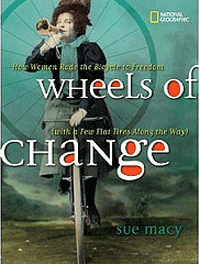(With a Few Flat Tires Along the Way)
By Sue Macy
National Geographic, 2011
$18.95, ages 8 and up, 96 pages
At the close of the 19th Century, the bicycle was like a silent steed for women -- helping them break free of society's rigid hold and carve their own dreams, according to this charming account.
"Imagine a population imprisoned by their very clothing: the stiff corsets, heavy skirts...," award-winning Macy writes. "...And how liberated they must have been as they pedaled their wheels toward new horizons."
"Imagine a population imprisoned by their very clothing: the stiff corsets, heavy skirts...," award-winning Macy writes. "...And how liberated they must have been as they pedaled their wheels toward new horizons."
With the arrival of the high-wheeler and later bicycles in America, women gained a degree of mobility they'd never known, and as such, they were gradually, often unconsciously led to try things that at the time only men were allowed to do.
The female cyclist "did not have to be born again in some mysterious fashion, becoming a strange creature, a 'new woman,'" Munsey's Magazine suggested in 1896. "She is more like the 'eternal feminine,' who has taken on wings, and who is using them with an ever increasing delight in her new power."
A few years later, a French cycling poster echoed this perception, showing a Athenian-looking woman with angel wings standing beside her two-wheeler.
The bicycle spurred a fundamental shift in how women were looked upon. Until then, women felt restricted to home and were strictly supervised; now they could hop on a bike and go for a ride and get exercise.
The advent of the two-wheeler "has done more to emancipate women than anything else in the world," wrote civil rights activist Susan B. Anthony in 1896. "I stand and rejoice every time I see a woman ride by on a wheel."
The advent of the two-wheeler "has done more to emancipate women than anything else in the world," wrote civil rights activist Susan B. Anthony in 1896. "I stand and rejoice every time I see a woman ride by on a wheel."
As more women took to pedals, "rational" fashion had to go, and along with it, straight-laced ideas of propriety.
Full skirts, corsets and bulky petticoats of the day were impractical, even dangerous. Fabric would catch in crank bracket and send women flying. So a less restrictive style of dress was born, beginning with ungainly bloomers and eventually shifting to shorter skirts.
Soon women felt encouraged to enter bicycle races and were joining other feminists in demanding the right for better schooling and jobs. However, the road to equality was bumpy, much like the dirt roads they rod
0 Comments on Wheels of Change as of 1/1/1900
Add a Comment



